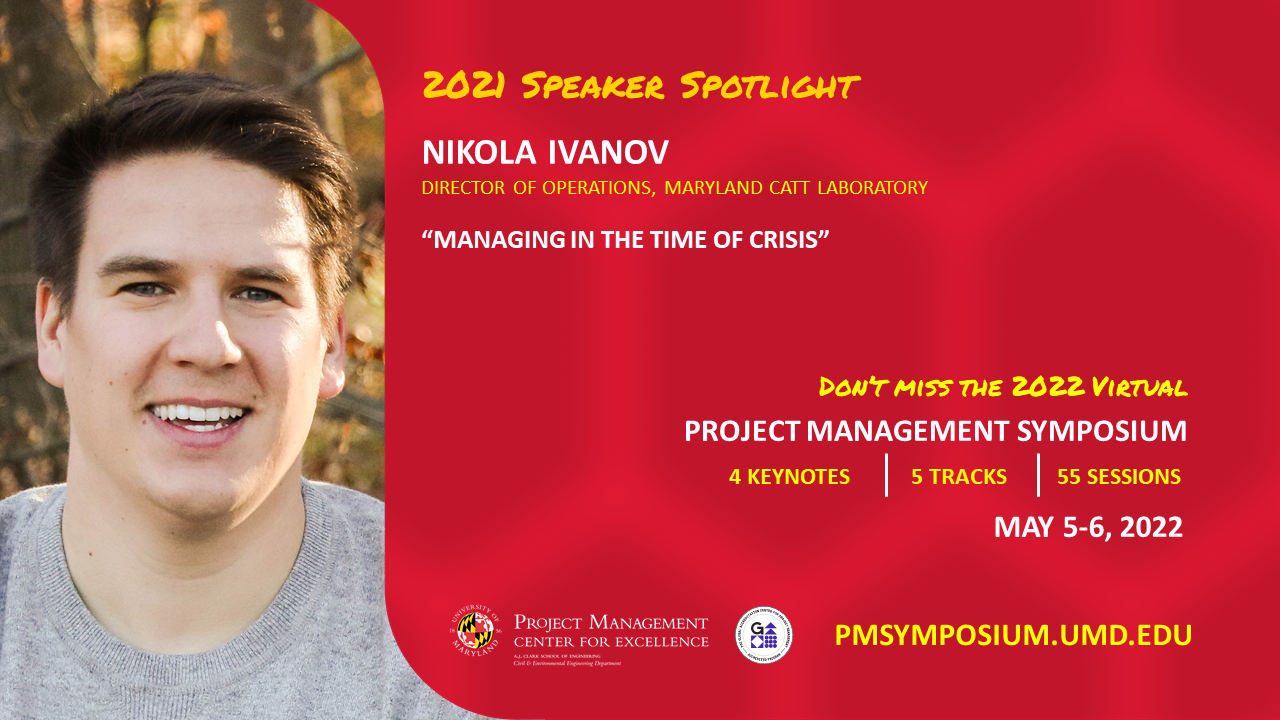In our 2021 Virtual Project Management Symposium Nikola Ivanov, who serves as Director of Operations at the Center for Advanced Transportation Technology Laboratory, presented a captivating session on “Managing in the Time of Crisis.” We felt his presentation was exceptional, so we decided to share his insights with you.
In times of crisis, some managers shine, and others do not. Perhaps you are faced with a major, public problem, or it could be something internal and more contained. It could be something specific to your organization, or something with global impact, like the COVID-19 pandemic. According to Nikola, one thing is for sure: Crises are intense, stressful and complex. There is no single “right” way to resolve them, and there is no easy way to recover.
His presentation explored different ways in which effective management during a crisis was the differentiator between a good project manager and a great one, while also raising questions about why a great project manager would allow a crisis to occur in the first place.

Let’s first be clear about the difference between risk management and crisis management. Project managers know that “project risk” is the exposure of stakeholders to the consequences of variations in outcome. You can plan proactively for risks because you can predict fairly accurately what they are and develop plans to mitigate them.
Ivanov described a “crisis” as an unforeseen, potentially devastating event or series of events. They’re fundamentally different because with risks, you can be proactive. But, in a crisis, you’re generally reactive, and your ability to make good choices given the options can be very limited.
He indicated that crises should be rare, and if you’re having them daily, weekly, or monthly, then perhaps you’re not having a crisis—it might be more like a systemic organizational issue that is not sustainable. Or perhaps, your worst risk has materialized, you had a risk you didn’t account for and that’s the one that materialized, or all your worst risks have materialized at once. If you’re operating in an environment with more risk than your business can sustain, there might be a serious flaw in your overall strategy.
Ivanov places crises in project management in three categories:
- Short-term, in which a crisis has an immediate project impact or possibly jeopardizes a phase of a project.
- Mid-term, which can be a crisis that impacts a larger project or multiple projects; or consecutive failed projects that points to a larger, systemic issue that is permeating the organization.
- Long-term crises, as we are currently seeing with the COVID-19 pandemic, is a completely unforeseen situation that is lingering longer than expected, and is causing entire business sectors to die out. This kind of crisis is externally imposed and has created organizational chaos that is either destroying the business or has caused it to pivot its focus at the brink of destruction in order to remain viable.
Certainly, project managers don’t want this happening often. You can work to avoid risks by developing strategic plans and position the organization in a way that helps reduce uncertainties. But, as heavyweight boxing champion Mike Tyson once said, “Everyone has a plan till they get punched in the mouth.”
Register for the 2022 Virtual Project Management Symposium Today
So, what are the key ideas to create effective crisis management when the worst happens?
First, Ivanov said that crises are an opportunity to transition from being a team leader or manager to a real “leader of leaders.” Empowering others to perform their best in a crisis is the mark of a true leader among leaders.
Next, avoiding a narrow view, or “tunnel vision,” in which you can only focus on the immediate problem, can be detrimental because this can prevent you from seeing the big picture and impact. In a crisis, he points out, we are often wasting time and energy by asking who is at fault for the situation. He calls this counterproductive to engaging the key decision-makers and coming up with an action plan.
In a crisis, good decision-making is another key, and although it’s counterintuitive, he recommends that leaders go for speed over precision. We’ve been taught that making decisions too quickly often leads to mistakes, but in a crisis, accomplishing even just part of the goal might be all you need to downgrade the crisis. Prioritize, make smart trade-offs, and then embrace action.
It is the leaders of leaders who possess the “key values” to manage the crisis. In his organization, there are 10 key values that are considered so important; they’re used on his employees’ performance evaluations. Top of the list is courage.
Empowering others to perform their best in a crisis is the mark of a true leader among leaders.
In a crisis, courage means making the right decision, even when it’s difficult. Managing fear—yours and others’ —as well as being rational and setting an example for those who are also afraid of the situation, is perhaps the most desirable quality in a leader. Some may not be thinking rationally and begin finger-pointing or blaming, but this is when the situation can go from bad to worse.
Fostering courage in the work environment happens over time. Consistently standing in support of calling out things that are against the values of the organization or personal values must be normalized in your organization’s culture, as well as listening and being heard.
Equally important is learning from the crisis. It’s a key value to ask, “What lessons did we learn for the future?” Then, implement those lessons or you’ll be bound to have the same problem again, and you could have a short- or mid-term crisis of your own doing because you didn’t adjust and integrate these lessons into your strategic approach.
Ivanov said it isn’t possible to prepare for every crisis or risk. But there are important steps any organization can take to prepare to be effective during a crisis.
Cultivating the right organizational culture is at the foundation of crisis management. He said that inspiring courage, ownership, and empowerment creates an environment of success. Encouraging people to address conflict during “normal” times will make it more reasonable when people are facing the conflict that comes with crisis. On a strategic level, he said leaders of leaders’ model the values that they hope to see in others before the crisis happens. It’s not possible to expect everyone suddenly to have courage and integrity in the moment of crisis. It has to be part of the work environment all along.
Practice and rehearsal have to be second nature to people. They must be accustomed to being empowered. Personality issues always exist; the key is to practice decision-making during a crisis so that when the time comes, it will fall into place. We have these processes established to use in a crisis, but if you never use them till the actual emergency arises, it’s not likely to work.
The real leaders of leaders widen their aperture during a crisis. They see the human aspects of the situation, and work to become a better, kinder, more compassionate leader—all the most critical elements to managing a situation in crisis. Kinder, more compassionate leadership became even more crucial in the last year, due to the work restrictions imposed by the COVID-19 pandemic.
No one had an event like this on their radar, but when it did occur, Ivanov said some of the procedures established for unforeseen crises were implemented quickly at his workplace. As a leader himself, he has had to change his own mindset as it pertained to the concept of working remotely. Although his organization prided itself on its flexibility, he said there was no policy about remote work, and he believed some people would take advantage or manipulate the work-from-home environment.
Upon reflection, he said he’d learned that he had been wrong. Although he described it as an “imperfect situation,” and some had in fact, abused the change to working remotely, there had been no devastating effects. However, there was great value in it for his employees. They were able to take care of children who were not in school plus they were able to continue work despite budget cuts. This increased their dedication to the organization because they saw it as willing to support them. “This is a great way to find courage,” he said. “You show you’re willing to change your thought about something.”
Unfortunately, there are leaders who are strong only when things are going well. This is when real leaders are tested: they do not shift blame, they do not ignore things, they don’t tell themselves that maybe the problem will not happen, they don’t have a bias to action. These qualities can be learned over time, but they require courage, introspection, self-awareness, and the ability to model the behavior they expect to see in others.
In this presentation Nikola articulates the difference between risk management in which most risks can be anticipated and proactively mitigated and crisis management in which the crisis cannot be anticipated. The key in crisis management is leadership and good decision making based on timely but not precise information. Leaders of leaders cultivate the culture as a foundation of crisis management. They practice and rehearse how to respond to the unexpected until it is second nature. The leaders are always looking for lessons learned and improving their processes.
If you are interested in reviewing presentations like this, check out the University of Maryland’s VIRTUAL Project Management Symposium to be held May 5-6, 2022. The event will feature 4 keynote speakers and 55 individual sessions in 5 concurrent tracks. More information can be found at the 2022 Virtual Project Management Symposium website. If you want access to the recording of Nikola Ivanov’s presentation, along with 56 other project management related sessions, you can register for access to the recordings from the 2021 Symposium for only $150.
Register for the 2022 Virtual Project Management Symposium Today

This article appeared in PM World Journal, Vol. X, Issue IX, October 2021.
How to cite this article: Cable, J. H. (2021). Managing in Times of Crisis, PM World Journal, Vol. X, Issue IX, October.
Posted by Kathy Frankle on October 6, 2021

 Data Analytics for the Project Manager
Data Analytics for the Project Manager